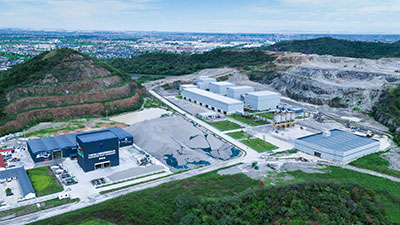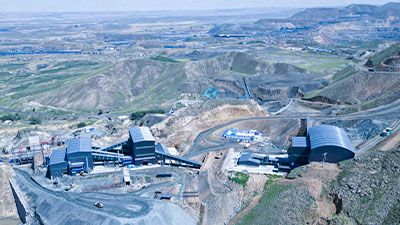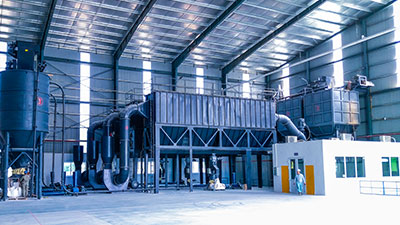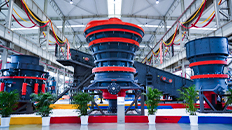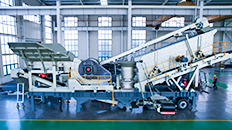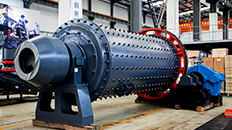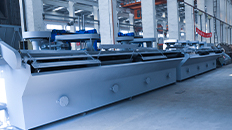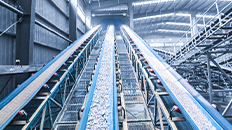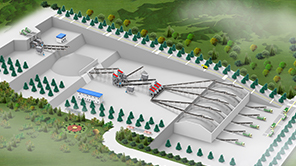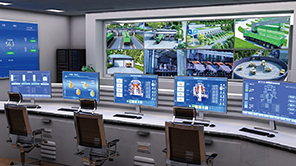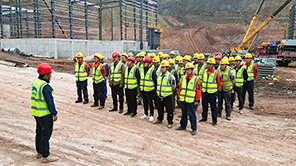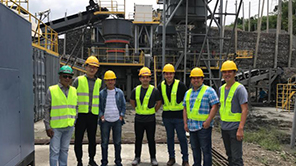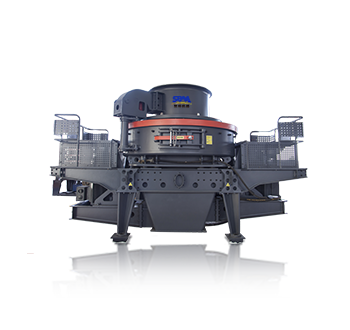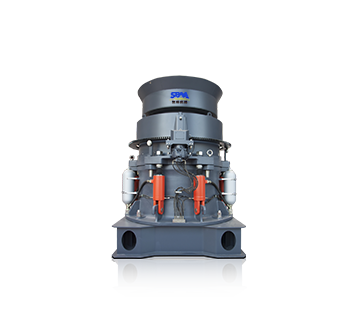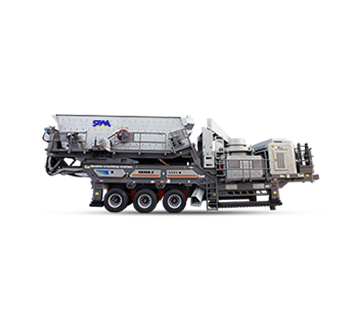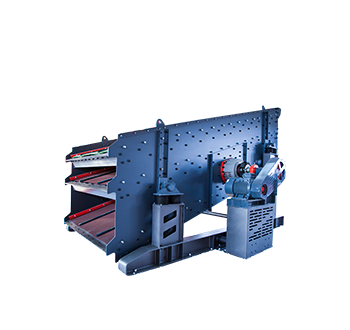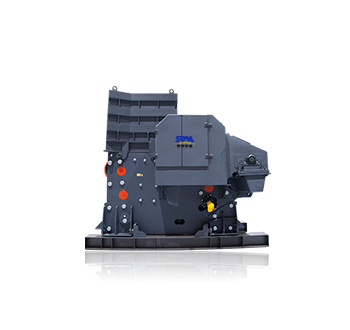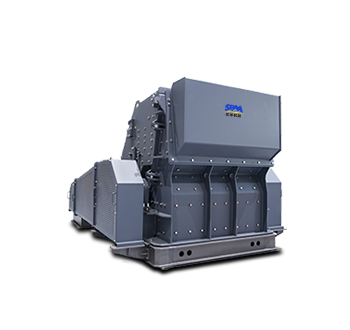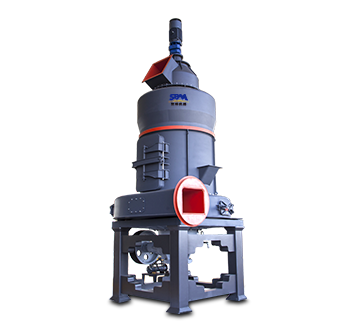Summary:According to the degree of fixation between the crushing equipment and the foundation, iron ore crushing stations can be divided into mobile, semi mobile, semi fixed, and fixed types.
With the comprehensive advancement of industrialization and urbanization, the demand for iron and steel materials has increased, leading to a significant increase in the development of iron ore resources, while promoting the research and production of iron ore crushing stations and crushers.
Before beneficiation, iron ore needs to be processed by a crusher to improve beneficiation grade. In order to get high crushing efficiency of iron ore, the adoption of suitable iron ore crushing stations has become a trend.

Classification and composition of iron ore crushing stations
According to the degree of fixation between the crushing equipment and the foundation, iron ore crushing stations can be divided into mobile, semi mobile, semi fixed, and fixed types.
Iron ore crushing station generally consists of four parts of equipment: feeding equipment, crushing equipment, buffer silo, and unloading equipment.
Feeding equipment is also divided into silos, feeding belts, and vibrating feeders;
The types of iron ore crushing equipment are various; the commonly used ones are jaw crusher, cone crusher and gyratory crusher;
The unloading equipment is a belt conveyor.
Characteristics and application of the 4 types of iron ore crushing stations
1, semi mobile crushing station
The semi mobile crushing station for iron ore is designed to place the machine body at a suitable working level in the open pit, and use crawler transporters or other traction (pulling) equipment to transport the crushing unit as a whole (or separately) as the working steps are advanced and extended.
As shown in the sectional drawing, the feeding equipment is a silo; the crushing equipment is gyratory crusher and the unloading equipment is a belt conveyor.
The most typical feature of a semi mobile crushing station is that it is not connected to a concrete foundation on the ground, and it needs to be transported integrally or separately by specialized relocation tools. Its service life varies from 2-5 years, and its one-time migration time usually does not exceed 48 hours.
An important feature is that semi mobile crushing stations are usually arranged on the working side of the stope.
2, mobile crushing station
The mobile crushing station for iron ore generally integrates feeding, crushing, and transportation into one set, and adopts crawler or tire type walking, which can adjust the position at any time as the working surface moves in the mining area.

The most typical feature of a mobile iron ore crushing station is that it is connected to the ground without concrete foundation, and it has the walking function to move closely with the movement of the working face.
More importantly, the iron ore is directly loaded to the crusher by excavator, eliminating the vehicle transportation link, thereby reducing production costs. However, the working conditions are harsh, requiring a minimum working platform width of 100m.
3, semi fixed crushing station
The semi fixed iron ore crushing station is a transitional way from a fixed crushing station to a semi mobile crushing station.
The semi fixed crushing station consists of five parts of devices: crane truss, feeding equipment, crushing equipment, buffer silo, and unloading equipment.
The crusher of a semi fixed crushing station is installed on a concrete foundation and does not have a walking function. With the extension of open pit mining, the crushing station can be moved downward multiple times. However, during relocation, only the equipment body connected to the foundation with bolts can be disassembled, moved, and reused. During relocation, it needs to be disassembled, and each independent component is transported to a new location by a transport vehicle for reassembly. The foundation buried below the ground surface is left unused.
The relocation of semi fixed iron ore crushing station is difficult, with a large amount of work. Generally, the relocation period does not exceed 10 years, and the relocation work cycle is 1 month. Therefore, it is generally located on the non-working side of the stope.
4, fixed crushing station
The fixed iron ore crushing station has a permanent concrete foundation, and its position remains unchanged throughout the entire service life of the open pit mine. It is generally located outside the stope, with long service life.
This type of iron ore crushing station is suitable for mines with relatively stable load distances, and is rarely used in deep open pit mines. The fixed crushing station consists of five parts of devices: crane truss, feeding equipment, crushing equipment, buffer silo, and unloading equipment.
The most typical feature of a fixed iron ore crushing station is that the crusher is installed on a concrete foundation and has a strong connection to the ground. It does not have a walking function and does not move, with the same life span as the mine. It is usually arranged outside the stope, not affected by the advancing and deepening of the stope steps, or arranged in the crushing workshop of the beneficiation plant.
How to choose the right iron ore crushers?
In iron ore beneficiation plant, the crushing stage generally includes coarse crushing, medium crushing and fine crushing process. The coarse crushing usually adopts jaw crusher or gyratory crusher, the medium and fine crushing adopt cone crusher.
Iron ore jaw crusher VS gyratory crusher
- 1. The gyratory crusher is mainly used for the first stage of coarse crushing of materials with different hardness, but it is not suitable for crushing viscous ores. Generally, gyratory crusher is used in large-scaled iron ore processing plants.
- 2. The jaw crusher can handle ores with high water content and high viscosity, and is not easily blocked. Generally, jaw crusher is used as coarse crushing equipment in small-scaled iron ore processing plants or quarries.
- 3. The gyratory crusher adopt continuous crushing, with its outstanding advantages of high productivity, high crushing ratio, up to 6-9.5, and in some cases, the crushing ratio can even reach to 13.5, and stable operation with low vibration. The crushing process of jaw crusher is discontinuous and the crushing efficiency is relatively low.
- 4. The gyratory crusher has a complex structure, high height and large volume, requiring higher factory, which leads to a relatively large investment in infrastructure construction. The jaw crusher has the advantages of simple structure, low manufacturing cost, small machine height, convenient configuration, and convenient maintenance.
- 5. The feeding size of the gyratory crusher is larger than that of the jaw crusher, while the discharge particle size is smaller and more uniform, and the content of needle and flake particles in the products is less. The feeding requirements for jaw crusher are strict. After blasting, large iron ore particles must be impacted and crushed to meet the feeding requirements of a coarse jaw crusher.
Iron ore cone crusher
For iron ore medium and fine crusher, you can choose SBM hydraulic cone crusher. Because its safety, adjustment, and locking functions are all realized by hydraulic devices, the hydraulic system can effectively ensure the safe operation of the equipment.
On the one hand, the equipment is wear-resistant and highly intelligent, and on the other hand, the grain size of the finished product is cubical and output capacity is high. SBM hydraulic cone crusher can withstand the crushing force and larger stroke of iron ore, and the special crushing chamber type adapted to the lamination crushing principle makes the crushing of iron ore have higher crushing efficiency.
Advantages:
If you want to set up an iron ore crushing plant and do not know how to choose suitable crushing station or crusher, contact SBM. We have professional engineers who can design suitable plant and recommend proper iron ore crushers for you!
- 1. Adopting the principle of laminated crushing and utilizing the mutual extrusion between materials, significantly improving the crushing efficiency and the proportion of fine materials, greatly reducing needle-like particles and reducing the steel consumption of vulnerable parts.
- 2. The cone crusher can still maintain high load capacity in high dust and high impact environments, and has low production costs; optimized lining plate fixing method, no need for glue filling, and the replacement is convenient and quick, reducing the maintenance costs.
- 3. The hydraulic adjustment device of the discharge opening has the advantages of low overload coefficient when passing through non crushing objects, and easy removal of non-crushing objects clogged in the crushing chamber.
- 4. The oil circuit of the safety cylinder adopts a large-diameter oil pipe and a large-capacity accumulator, which has better cushioning performance, faster response, safer equipment, and long service life.

